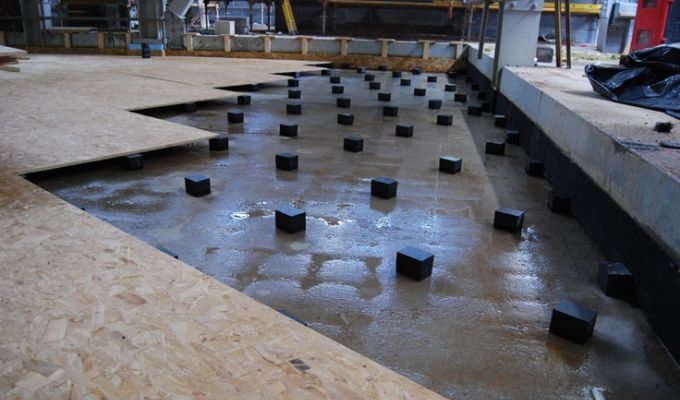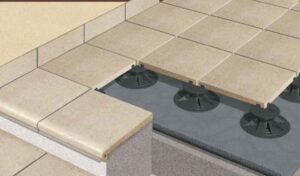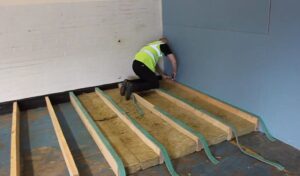In our increasingly noisy world, the need for effective soundproofing in residential, commercial, and industrial spaces has become a high priority. Whether you’re living in a bustling urban apartment, working in a busy office building, or managing a sound-sensitive environment like a recording studio or a hospital, noise can severely impact comfort, productivity, and overall quality of life. One solution that has gained significant attention for its effectiveness and versatility is the floating floor system.
This innovative flooring method offers a powerful approach to managing unwanted sound by addressing both impact and airborne noise. In this blog, we’ll explore what floating floors are, how they work, their advantages, and why they are becoming the go-to option for professionals seeking acoustic performance.
What Is a Floating Floor?
A floating floor refers to a flooring system that is not nailed or glued to the subfloor beneath. Instead, the flooring “floats” over a sound-absorbing underlayment or cushioning layer. This design creates a decoupled surface that reduces the transfer of vibrations and sound waves, effectively isolating the floor from the building structure.
Floating floors can be made from various materials, including:
- Engineered wood
- Laminate
- Vinyl
- Rubber
- Acoustic panels or concrete over resilient layers (in industrial setups)
The key to the floating floor’s acoustic performance lies in the materials used beneath the top layer. These include resilient mats, foam pads, or rubberized membranes that absorb sound and reduce the transmission of vibrations from footfalls, machinery, or dropped objects.
How Floating Floors Reduce Noise
Noise can travel through structures in two primary ways: airborne (such as talking or music) and impact (such as footsteps or furniture movement). A floating floor system tackles both forms effectively:
1.Reduction of Impact Noise: The decoupling effect of a floating floor stops vibrations caused by impacts from traveling directly through the structure. This means the sound from walking, dropping items, or moving furniture is significantly minimized in the spaces below.
2. Control of Airborne Sound: In some floating floor setups, additional mass and damping materials can be added to improve insulation against airborne noise. Combined with good wall and ceiling treatments, floating floors contribute to an overall acoustically balanced environment.
By minimizing the direct connection between the walking surface and the subfloor, floating floors eliminate the major pathways for noise transmission.
Where Are Floating Floors Most Effective?
Floating floor systems are highly versatile and can be used in a variety of environments, including:
- Recording Studios and Music Rooms: Where sound isolation is critical to prevent outside noise from interfering with recording, and vice versa.
- Home Theaters: To keep the booming sound of movie scenes from disturbing the rest of the household or neighboring units.
- Multi-family Residences and Apartments: To reduce noise complaints caused by foot traffic, dropped objects, or children playing.
- Offices and Conference Rooms: For creating quieter, more focused workspaces and reducing the noise between floors.
- Hospitals and Laboratories: Where both patient comfort and noise control for sensitive equipment are priorities.
- Educational Institutions: To ensure quieter classrooms and study areas free from external disturbances.
Advantages of Installing Floating Floors
Floating floors offer several compelling benefits that go beyond noise control:
- Easy Installation: Since there’s no need for adhesives or nails, installation is faster and often more cost-effective.
- Versatility: Compatible with a wide variety of surface finishes, floating floors fit into modern, traditional, or industrial designs.
- Thermal Insulation: Many underlayments also provide thermal insulation, making rooms warmer and more energy-efficient.
- Moisture Protection: When combined with moisture barriers, floating floors are resistant to minor spills and humidity.
- Durability and Maintenance: With proper installation, floating floors are long-lasting and easy to maintain, offering value for years to come.
- Reversibility: They can be removed or replaced without damaging the subfloor, making them ideal for leased properties.
In addition to their functionality, floating floors offer aesthetic freedom. With endless design options—woodgrain textures, stone patterns, bold colors—they can enhance the visual appeal of any space while delivering top-notch acoustic benefits.
Considerations Before Installing a Floating Floor
While floating floors are a fantastic solution for many scenarios, it’s important to assess the following before installation:
- Subfloor Condition: Ensure the base floor is level and clean to avoid warping or shifting.
- Load-Bearing Needs: In heavy-use industrial or commercial environments, the floating system must be engineered to withstand weight and equipment.
- Material Selection: Acoustic performance varies with materials used—consulting with an expert can help in choosing the right combination.
- Compatibility with Existing Infrastructure: Check if doors, baseboards, and other fixtures will need adjustments to accommodate floor height changes.
Partnering with an experienced acoustics consultant or installer ensures that the floating floor is tailored to your specific noise reduction goals and functional needs.
Conclusion: Why Choose Perfect Acoustics for Floating Floor Solutions?
If you’re serious about reducing noise in your space, investing in a floating floor system is a strategic and sustainable decision. Whether you need enhanced soundproofing for a high-end recording studio or want peace and quiet in your apartment, floating floors deliver measurable results.
For the best in class when it comes to floating floor installations and sound control expertise, Perfect Acoustics stands out as a trusted leader in the industry. With a proven track record in designing and installing customized acoustic solutions, Perfect Acoustics ensures that every project meets the highest standards of performance and aesthetics. Their dedication to quality materials, innovative techniques, and customer satisfaction makes them the go-to partner for all your acoustic needs.



